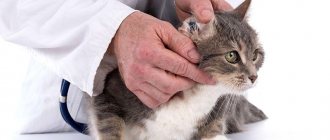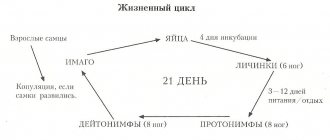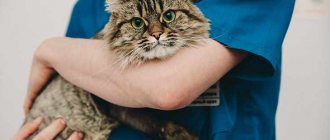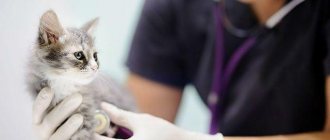Causes of hemoperitoneum in cats Signs Diagnosis Treatment Home care
Hemoperitoneum (hemoabdomen) is an accumulation of blood in the abdominal cavity, occurs after intra-abdominal bleeding, when blood accumulates in the space between the abdominal wall and the abdominal organs.
Hemoperitoneum is a potentially life-threatening situation. The abdominal cavity is a large space that can hold a significant amount of blood. At the same time, the abdominal muscles are stretched, and an increase in abdominal volume becomes obvious. An enlarged abdomen can cause discomfort or pain, leading to agitation and stress, and pressure on the diaphragm can interfere with breathing.
Rapid loss of blood into the abdominal cavity results in decreased tissue perfusion (blood supply) and a drop in blood pressure, which can cause shock. Loss of blood leads to anemia, mucous membranes turn pale. If such a patient is not given immediate veterinary attention, rapid blood loss can lead to death. However, gradual blood loss is more common, which allows the animal to receive the necessary help.
Chronic blood loss occurs more slowly and symptoms are less severe. With slow blood loss, some of the free blood from the abdominal cavity may be absorbed; thus, the animal will have a small volume of blood in the abdominal cavity. This situation may not seem like an emergency, but the animals have a severe primary illness. In these cases, it is extremely important to notice hemoperitoneum and make the correct diagnosis.
If the cat has normal blood clotting parameters, then bleeding into the abdominal cavity can stop on its own: blood clots form, which stop the bleeding. Sometimes cats lose consciousness due to sudden blood loss, and then spontaneously recover due to the body's compensatory abilities. Such animals may have periods of weakness followed by normal well-being. If blood clots are displaced (for example, when an animal moves), bleeding into the abdominal cavity may resume.
Causes of hemoperitoneum in cats
Traumatic injury – most often causes bleeding into the abdominal cavity, especially in cats with outdoor access. Depending on the size and number of damaged vessels, the degree and rate of blood loss will vary.
Abdominal neoplasms - can rupture and cause massive bleeding, bleed slowly, or grow into a blood vessel and disrupt its integrity. Tumors are more common in older cats.
Hematomas are confined collections of blood that can rupture and bleed. Hematomas usually develop due to vascular damage due to trauma.
Coagulopathy - bleeding disorders, in addition to hemoperitoneum, can cause bleeding in other places. Usually such bleeding does not stop on its own. Coagulopathies often occur due to poisoning by rat poison, but can also be caused by other reasons.
Depending on the rate and extent of blood loss, hemoperitoneum may represent an emergency.
Blood in stool
It is possible that you will find blood not on the cat's body, but in the feces. Sometimes this phenomenon is not something terrible. For example, if there was little blood and this case turned out to be an isolated incident, then most likely the reason is that during defecation, hard feces scratched the mucous membrane of the rectum and damaged the anal sphincter. To prevent this from happening in the future, provide your cat with constant access to fresh water. You can also give not only dry, but also wet food of a similar class. If blood is constantly detected in the stool, then you need to consult a specialist. He will conduct an examination and identify the true cause. The problem may be caused by the following reasons:
- bacterial infection; - helminths; - allergic reaction; - polyps and tumors in the intestines; - poor blood clotting (in this case, most likely, bleeding will be found not only in the stool).
Any of these problems are extremely serious and can threaten the health and even life of the cat. And each of them requires specific treatment. Therefore, it is important to make the correct diagnosis as quickly as possible and prescribe an appropriate course of therapy.
Diagnostics
A history and physical examination are essential for a quick and accurate diagnosis. In the case of a critical condition of an animal, its life depends on the speed of diagnosis and initiation of adequate treatment.
Your veterinarian may also recommend:
- X-ray of the abdominal cavity - allows you to detect the presence of free fluid in the abdominal cavity, as well as massive formations: tumors and hematomas.
- Puncture of the abdomen using a needle and syringe to obtain a sample of fluid for testing - with hemoperitoneum, the fluid will look like blood but will not clot.
- Analysis of the resulting sample - with hemoperitoneum, the hematocrit of the liquid will be close to the hematocrit of the patient's blood.
- A complete blood test will allow you to assess the degree of anemia due to blood loss, as well as understand whether the bleeding is acute or chronic.
If necessary, additional research is carried out:
- A biochemical blood test will allow you to assess the degree of damage to internal organs. Animals with recent trauma typically have elevated liver enzymes. It is also important to assess renal function.
- Coagulogram - allows you to identify blood clotting disorders.
- Ultrasound examination of the abdominal cavity - allows you to identify the presence of neoplasms in the abdominal cavity.
- CT or MRI - allow you to visualize tumors that are not accessible to ultrasound.
Before carrying out a full diagnosis, the animal’s condition must always be stabilized!
Signs of bleeding
Uterine bleeding in a cat can be hidden or open. When the cervix is closed, the bleeding that opens has no way out. Blood is released into the uterine cavity, accompanied by symptoms such as loss of appetite, low mobility, lethargy and apathy. Shortness of breath and a decrease in body temperature may occur.
On palpation, the pet’s abdomen is tense and enlarged in size. Large internal blood loss leads to iron deficiency anemia. Visible mucous membranes become pale (anemic).
Signs of internal uterine bleeding increase gradually, varying from several days to 2-3 weeks. The leaking blood remains in the uterine cavity with no outlet, which causes pain in the peritoneal area of the pet.
The open type of uterine bleeding is characterized by more pronounced symptoms:
- the animal constantly licks the perineal area;
- dried brown spots are visible on the root of the tail;
- with little activity or after the animal sleeps, the owner may find drops of blood on the bedding.
Any type of uterine bleeding poses a serious danger to the health of the animal, therefore, if one of the characteristic signs is detected, it is necessary to immediately contact a veterinary clinic for further diagnosis and adequate treatment.
Treatment
Treatment depends on the cause of the disease and the clinical condition of the cat. If the animal is critically ill, symptomatic treatment should be started before diagnosis is made.
Therapy may include:
- Abdominal puncture (if pressure on the diaphragm prevents breathing).
- Intravenous infusion - intravenous administration of solutions helps maintain blood pressure and improve organ and tissue perfusion, which is critical for animals in shock.
- Blood transfusion – for severe anemia.
- Pressure bandage on the abdomen - a bandage increases intra-abdominal pressure, which helps slow down or stop bleeding.
- Oxygen therapy is necessary for animals with large blood loss, especially in the early stages of treatment.
- Pain relief – reduces stress and improves the condition of patients.
- The purpose of vitamin K is for coagulopathies caused by poisoning with rat poison and other anticoagulants.
- Emergency diagnostic surgery - if there is a tumor in the abdominal cavity, or bleeding (with normal blood clotting) does not stop, despite treatment.
What is bleeding and why is it dangerous for a cat?
A cat's heart pumps a certain amount of blood through its circulatory system. Passing through the vessels, blood supplies the tissues and organs of the animal with the necessary amount of oxygen, participates in local metabolic processes and performs a protective function, fighting local inflammation.
If for any reason the integrity of the walls of blood vessels is compromised, some of the blood will be able to leave its usual route. The process of blood loss from the bloodstream due to damage to the walls of blood vessels is called bleeding.
When bleeding, part of the blood leaves the bloodstream through damage in the walls of blood vessels
If the bleeding is minor and does not recur regularly, the body of a healthy animal is able to cope with it without outside help. In this case, a protective mechanism is triggered: the vessels reflexively contract, and clots of coagulated blood form at the sites of their damage, stopping blood loss. The consequences of such bleeding are usually not dangerous for the cat.
But significant blood loss, which the body lacks its own strength to combat, poses a threat to the life of the animal. As a result of serious bleeding:
- the mechanics of blood circulation are disrupted;
- The blood vessels and heart are not filled enough;
- blood pressure drops;
- acute anemia develops (the number of red blood cells and the level of hemoglobin in the blood sharply decreases);
- the process of oxygen delivery to organs and tissues is disrupted;
- hypoxia (oxygen starvation) of tissues occurs;
- local metabolic processes are disrupted;
- cell death occurs and, as a consequence, the death of the entire organism.
Typically, a cat's death results from the loss of 2/3 to 3/4 of its total blood volume.
Home care
Hemoperitoneum can be an emergency and veterinary attention should be sought as soon as possible. Minimize stress until you can get to the veterinary clinic, keep the animal warm, and ensure peace. If traumatic injury is suspected, be careful when moving your pet as spinal injuries or fractures may be present.
(c) Veterinary center for the treatment and rehabilitation of animals “Zoostatus”. Varshavskoe highway, 125 building 1. tel. 8 (499) 372-27-37
First aid for nosebleeds in animals
Having noticed that the pet is bleeding from the nose, the owner must calm down himself, and then carefully examine the animal to determine the degree of complexity of the situation. After this, it is necessary to calm the animal to avoid an increase in blood pressure. There is no need to give sedatives or other medications without consulting a veterinarian.
In case of severe bleeding, you need to apply a cooling compress by applying ice to the animal’s nose. If your cat does not get better over time, you should immediately consult a doctor.
What are the consequences if low hemoglobin is not treated?
Oxygen delivered by hemoglobin ensures the normal functioning of all organs. If it is not enough, then functional and organic changes begin, resulting in a life-threatening condition. The degree of damage depends on the duration of oxygen starvation, and the consequences lead to the formation of a number of pathologies:
- painful changes in the liver;
- development of shortness of breath;
- the appearance of pathological changes in the vascular and cardiac systems;
- disruptions in the functioning of the nervous structure;
- changes in the composition of the blood, a decrease in red blood cells - anemia;
- development of atherosclerosis;
- exacerbation of chronic diseases.
A slight decrease in hemoglobin relative to the norm is associated with weakness and increased fatigue. As the gap in indicators increases, a depressive state and irritability appear.
Note! A large lack of hemoglobin in pregnant women is fraught with premature birth and the development of hypoxia in the unborn child.
Reasons for appearance
If you notice blood from the cat’s vagina, you should not hesitate, hoping for an independent cure for the pathology. As a rule, bleeding from the genital organs of an animal is associated with pathological changes. Common causes of bloody discharge from the loop are:
- Inflammatory processes - endometritis and pyometra, as well as other pathologies of the reproductive system characterized by inflammation. Pathological changes in the endometrium lead to anxiety in the animal, accompanied by aggression and constant licking of the genitals.
- Violation of the integrity of the walls of the uterus. The reproductive organ in cats has a special structure - in the form of horns. The walls of the uterus are unusually supplied with blood, and with even minor damage, severe bleeding is observed, affecting the condition of the animal. Providing assistance in these cases must be immediate, since in a short period of time the animal can simply bleed to death.
- Malignant neoplasms in the genital organs. Oncology of internal organs does not make itself felt for a long time, but with the growth of a cancerous tumor, irreversible degenerative processes begin in healthy cells of the body. With cancer of the uterus, ovaries or other structures of the reproductive system in cats, discharge with blood and pus is observed, characterized by an unpleasant odor, which is associated with the growth and subsequent destruction of tumor cells.
- Unseparated placenta or placenta. After giving birth to a cat, it is recommended to visit a veterinary clinic and conduct an ultrasound examination of the reproductive organs. This is due to the fact that parts of the placenta can remain inside, rotting and causing inflammation. As a result of the placenta decomposing inside the uterus, purulent vaginal discharge mixed with blood appears. As a rule, treatment involves abdominal surgery followed by removal of the uterus.
- Blood after sterilization. Sterilization of a cat is carried out not only to stop the production of offspring, but also to prevent sexual heat in cats. Often, cat owners decide to undergo surgery in the clinic in order to prevent dangerous diseases of the reproductive system in cats (endometritis, ovarian cancer, pyometra). In some cases, with neoplasms in the area of the adrenal glands or milk bags, blood may be released from the vagina. If hysterotomy (removal of the uterus) was not performed during surgery, the appearance of cystic neoplasms in the uterine cavity can also cause bloody discharge in the operated animal. The causes of bleeding in a sterilized animal may also be associated with the presence of germ cells in other organs of the animal. This pathological phenomenon is rarely diagnosed, but in some cases it still happens.
How to prevent low hemoglobin?
Often, iron deficiency occurs due to an unbalanced diet, when the body does not receive enough of those elements that are involved in hematopoiesis, and their incompatibility leads to a decrease in red blood cells. There are so-called risk groups that should pay increased attention to their blood composition:
- pregnant women;
- patients with a history of chronic diseases;
- taking hormonal and anticonvulsant medications;
- cancer patients;
- with liver pathology;
- children in adolescence.
Oxygen for the body is the ability of each organ to function without failures. Hemoglobin will ensure the respiration of the body as a whole if its indicators correspond to the norm. To do this, you need to take care of your health: undergo timely examinations, take tests, and visit a doctor. The measures are simple, but effective. Compliance with them makes it possible to keep hemoglobin at the required level, which, in turn, eliminates anemia and other pathological changes.
Consultations on ways to prevent low hemoglobin can be obtained from hematologists at the EL Clinic. They not only provide qualified treatment, but also explain to patients the rules of prevention.











